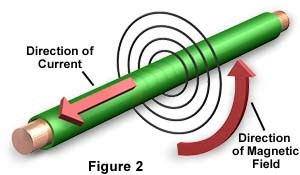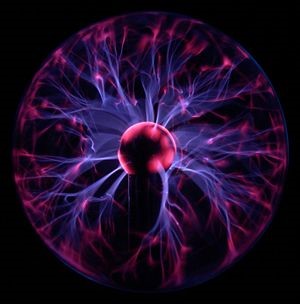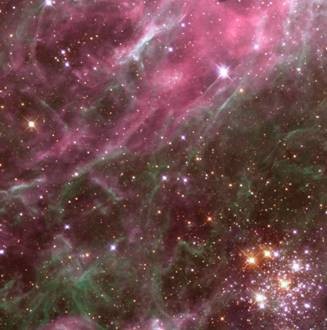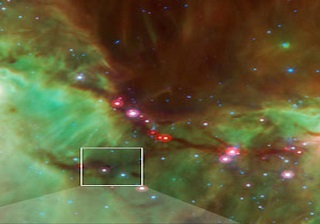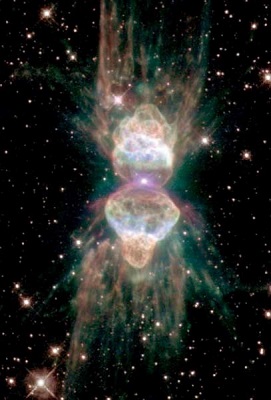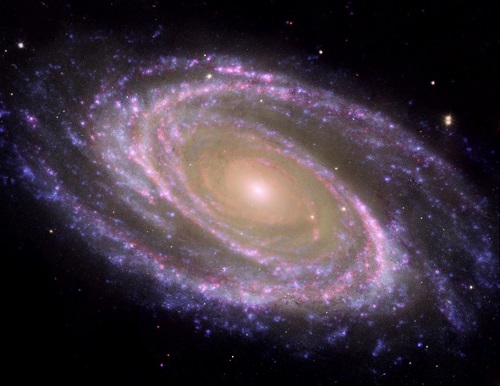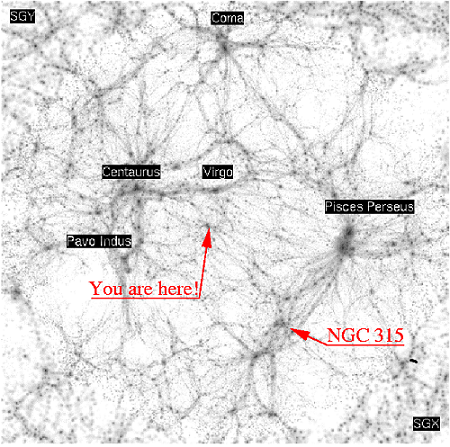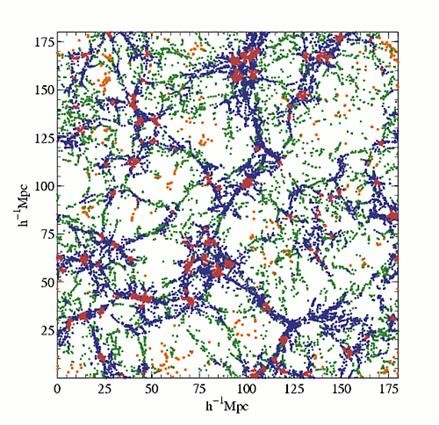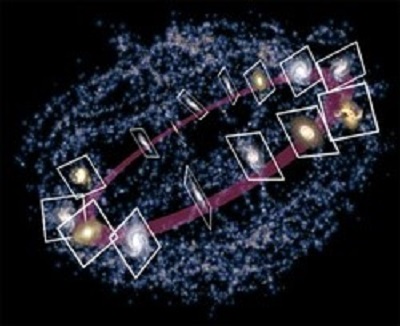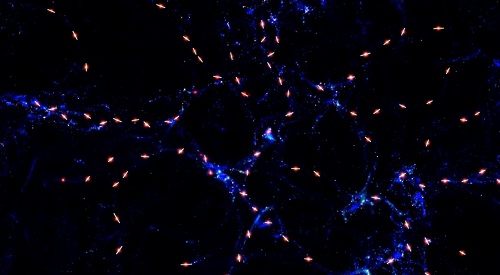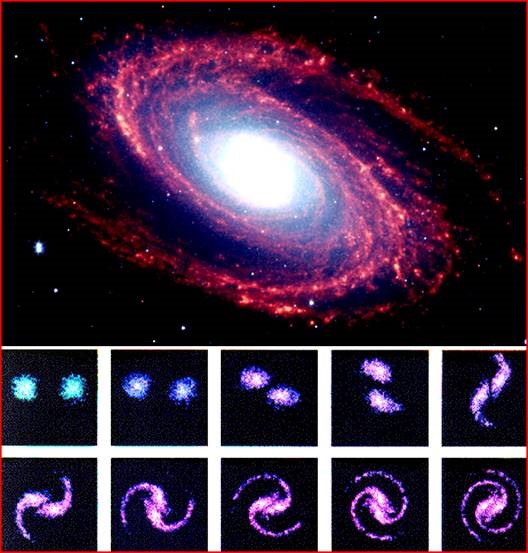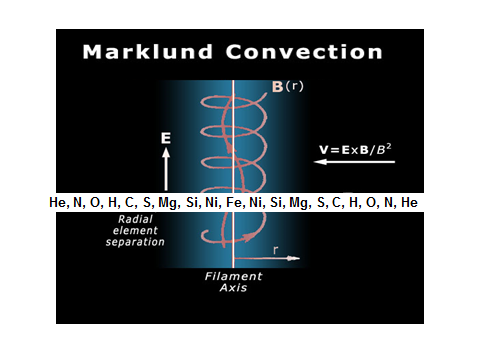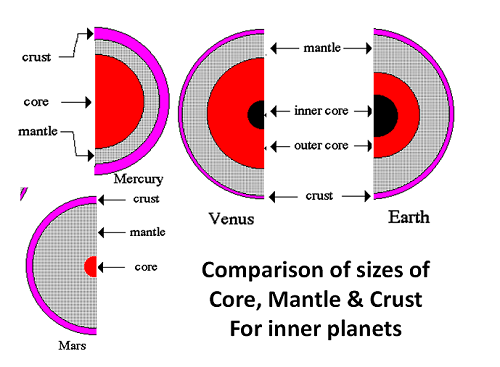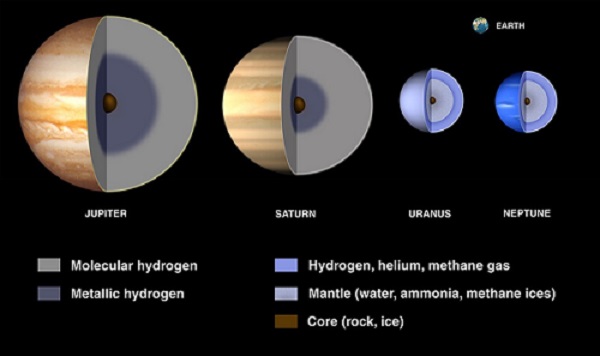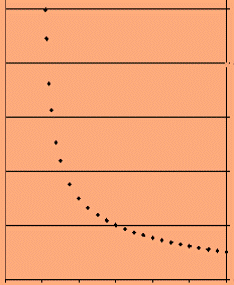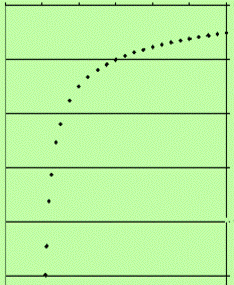return to Putting It All Together
Plasma Physics, Astronomy and the ZPE ModelPlasma PhysicsThere are three states of matter that most of us are familiar with: solid, liquid and gas. But a fourth state of matter also exists: plasma. A plasma is formed when one or more electrons are stripped off atoms in a gas. This is illustrated in Figure 1. Typical examples of plasmas are neon signs or fluorescent lights, the aurora borealis, lightning, the surface of the sun, or even flames. Over 99% of matter in the cosmos is in plasma form.
Plasmas are made of charged particles. For example, an atom with too few electrons is an ion, and carries a positive charge because of the protons in its nucleus. The nucleus also contains neutrons which are electrically neutral. In the case of atoms of normal hydrogen, the most abundant element in the universe, it has no neutrons in the nucleus. So when an electron is stripped off, only a proton is left, which has a positive charge. The electron is free to wander and carries a negative charge. When the positive ions or protons and/or the negative electrons in plasma are in motion, they form electric currents, because electric currents come from moving charges such as these. Currents in plasma do not require all atoms in the vicinity to be ionized or have their electrons stripped off. In fact, if only 1% of the atoms in a gas are ionized, the entire gas will behave as a plasma, and the motion of its electrons, protons or ions will constitute an electric current.
All electric currents have circling magnetic fields, as illustrated in Figure 2. Indeed an electric current in one form or another is the only known origin for magnetic fields. For example, in the case of a bar magnet, all the atoms have orbiting electrons (charges in motion and hence a current) arranged so that their orbits line up to give a consistent magnetic field. In the case of plasma, the magnetic field surrounding a current tends to confine the current into a cylindrical form. As a result, the circling magnetic field forms the plasma into spaghetti-like filaments or sheets. Because of this, plasmas always have electric currents, magnetic fields and voltage differences associated with them. A plasma ball with filaments and sheets is in Figure 3 (left), with plasma filaments and sheets in space shown on the right.
Plasma Physics and Astronomy Plasma physics has recently opened up new vistas in astronomy based on the interaction of electric and magnetic fields in plasma filaments and sheets [1]. As spacecraft and telescopes have examined the structure of our own Galaxy, the Milky Way, astronomers received a surprise. The plasma filaments were everywhere. They were first noticed by Dutch radio-astronomer Gerrit Verschuur from 1995 to 1999. When examining clouds, which were thought to be neutral hydrogen, he found they were actually enormously long plasma filaments carrying currents of up to 10,000 billion amperes. Later, on 12th January 2006, as reported in the UC Berkeley press, a huge section of the constellation Orion was found to be made up of a rod-like cloud with what was called a “magnetic slinky” spiraling around it. The current needed to provide this circling magnetic field, which made up the “slinky,” must be enormous. What was found is shown below in Figure 4.
More recently, on 1st June, 2015, the European Space Agency announced in a News Release that the Herschel Space Observatory had made the following observations about our whole galaxy: “We detected a wealth of huge filaments, with lengths ranging from a few to a hundred light-years, revealing what seems to be the 'skeleton' of our Galaxy…The omnipresent aspect of filamentary structures in the Milky Way is beyond doubt.” They went on to announce that stars are formed preferentially along these filaments: “A detailed study … suggests that star formation along filaments is the preferential channel to produce typical solar-type stars, while stars that are born away from these dense, elongated structures tend to have lower masses.” Plasma Physics and Star Formation The formation of stars along filaments has been proven by other recent studies. In the Orion nebula alone, the Greenbank telescope in August of 2014 found a complex of star-forming filaments 10 light years long as shown in Figure 5 (left). The Spitzer Space Telescope gave false-color infra red images of stars that had formed along other filaments in Orion as in Figure 5 (right).
In each case, the stars had formed on the filaments like beads on a string. This is important, as plasma physics explains how this can happen. In a plasma filament with its circling magnetic field, any instability in the electric current flow, or a temperature change along the filament, will cause the magnetic field to pinch in and compress the plasma into a ball. This is called the Bennett Pinch or Z-Pinch and is illustrated in Figure 6 (Left). We clearly see this effect elsewhere. Thus, in the case of the Ant Nebula (Figure 6 center) the parallel edges of the filament can be seen, with the pinching of the magnetic field to form the central star being obvious. Another example is the Wings of a Butterfly nebula (Right). Gravity is not needed to form stars in plasma physics.
Because we are a part of our Milky Way galaxy, which comprises 150 billion stars, it is more difficult to conceive what it looks like when viewed from the outside. Some idea might be given to us by the relatively nearby galaxy M81. The Spitzer and Hubble craft have given us a combined false-color image which shows plainly how the stars are formed along the spiral arm filaments like beads on a string. This is seen in Figure 7, below.
Plasma Physics and Galaxy Distribution In 1963, plasma physics pioneer Hannes Alfven predicted that galaxy distribution in the universe would prove to be filamentary. Much later, it was discovered that 99% of all matter in the universe was in the form of plasma. Then in 1991, the first galaxy distribution survey revealed that galaxies were indeed distributed in a filamentary structure. A plot of galaxy positions, that is, a map of the nearby universe, is shown in Figure 8.
This is obviously a filamentary distribution and astronomers were caught by surprise. No-one expected that result as it would not normally form like that under the action of gravity. As the surveys sampled greater distances, it was found that the filamentary distribution continued. Thus a survey of medium distance galaxies gave a result as shown in Figure 9 where our own location in space is in the bottom left hand corner.
A filamentary universe is very difficult to account for gravitationally unless there is the action of very finely tuned quantities of dark matter, whose existence has yet to be established. The situation became complicated further in 2010 when a Sloan Digital Sky Survey noted that galaxies had their spin axes aligned along the filaments that they were part of, again like beads on a string. This result was illustrated by New Scientist with the diagram shown in Figure 10.
Then on 20th November, 2014, astronomers received another shock. The Very Large Telescope in Chile had just found that the spin axes of 93 quasars at the frontiers of the cosmos were also lined up along enormously long filaments. In some cases, the quasars on these filaments are separated by billions of light years. A good report on this was in the UK Daily Mail. The map that was produced appears in Figure 11.
To this might be added the discovery announced on 5th Nov. 2013 of the Hercules-Corona Borealis Great Wall. It is the largest filament of galaxies ever found. The filament is 10 billion Light Years away and 8 billion LY long. This is a big problem. Dr. Jon Hakkila, professor of astrophysics at the College of Charleston, South Carolina, and one of the astronomers who discovered the structure, explains it this way: “The Hercules-Corona Borealis Great Wall is larger than the theoretical upper limit on how big universal structures can be [under gravitational interactions]. Thus, it is a conundrum: it shouldn't exist but apparently does.” Plasma physics does not have the limitations that gravitational physics imposes on the size or distribution of such structures. Plasma Physics and Galaxy Formation The inevitable conclusion from all this evidence is that plasma processes have probably formed the universe, the galaxies, stars and planets. This overthrows the gravitational paradigm which has ruled astronomy for over 300 years and which had been used to account for all we see in the universe. The advent of plasma physics applied to astronomy opens new vistas. We have already seen how stars can form by plasma processes. Experiments and simulations by Anthony Peratt in the Los Alamos National Laboratories have now shown how galaxies can form [1]. Interacting plasma filaments in the lab will form, in miniature, the whole sequence of galaxy types that we see out in space (see Figure 12). Since plasma interactions scale in a manner proportional to size, these lab results can be up-scaled to cosmic dimensions and applied at intergalactic distances.
The laboratory sequence of events shown in Figure 12 had two interacting filaments with parallel currents. As they approached each other, there was the development of a radio-galaxy with two lobes (top line, 2nd from the right). Not shown there is the compressed plasma between them forming a nucleus, but it is evident on plasma density images. Then quasars develop, followed by elliptical galaxies. As the interaction goes on, a barred spiral galaxy forms in miniature (bottom row left frames). Finally, as the arms lengthen, a full normal spiral galaxy forms (end of bottom row). The number of arms varies with the parameters of each interaction. In the lab, this process of miniature galaxy formation only takes fractions of seconds to seconds to accomplish. Plasma Physics and Planets In the case of planet formation two other facts emerge from plasma physics which are important. First, stars are usually formed along filaments. However, a major filament, such as those involved in star-making, can break up into a number of minor or sub-filaments by a filamentation instability. This instability will often leave a large filament in the center but it will have lesser filaments around it, rather like a conduit with lesser wires around a large central wire that goes to make up a cable. Another picture would be a stick of string cheese made up of a large central piece and surrounded by lesser strings. It is from this process that planets can develop when the major filament, which has broken up into lesser filaments, undergoes a Bennett pinch. The pinch begins at the outside and works its way in. As each lesser filament pinches, a planetary ball forms, with the large central filament becoming a ball and lighting up last of all. So, on this model, the Sun formed last in the Solar System. Second, in each plasma filament, sorting of ions (or atoms stripped of electrons) occurs. The process is known as Marklund Convection. In this process, the atoms of elements whose electrons can be stripped off most easily collect in the center. The atoms of elements whose electrons are the most difficult to strip off (or ionize), will collect at the outer edge of the filament. The atoms of other elements are graded in between. So the sorting of elements by Marklund Convection is an ionization sequence and predictable. The order of the main elements sorted in a plasma filament by this process is shown in Figure 13.
From Figure 13, it can be seen that atoms of the elements iron and nickel tend to collect at the center of the filament, with silicon and other similar elements in the middle. These are followed by carbon, hydrogen and oxygen, then nitrogen and finally helium. This is of considerable importance. Planet earth, for example, has a nickel-iron core, a mantle made up of various silicates, with hydrogen and oxygen combined to give a water-rich layer called the asthenosphere immediately beneath the crust and oceans above the crust. Then there is an atmosphere of oxygen and nitrogen. This is the same sequence as Marklund Convection in filaments (Figure 14)
Figure 14: Internal structure and composition of the Earth However, this goes much further. Marklund Convection will occur firstly in the primary filament out of which our solar system formed. Second, the process will also occur within each sub-filament which formed the individual planets. This sorting in the primary filament will determine the predominant composition of a planet going from the Sun outwards. Then, secondly, the layering in each planet is dependent upon sorting in the sub-filament. This is illustrated in the sequence of planets. For the inner planets, the size of the iron cores decreases as a function of planet diameter going out from the sun, while silicate mantle size increases (see Figure 15).
In the case of the outer planets, they have relatively small metal and rock cores, with metallic hydrogen lower mantles, then their upper sectors made up of water, methane and ammonia ices. Note that carbon and hydrogen are nearby each other in the Marklund sequence, so that methane as well as ammonia (from the nitrogen) will be formed. The amount of methane and ammonia increases as we go out in this planetary sequence (Figure 16). This is entirely predictable from Marklund Convection.
Figure 16: The structure and basic compositions of the outer planets also follow Marklund Convection. One final fact about Marklund convection and planets is needed. When an ion comes to rest in the filament under the action of Marklund Convection, it ends up as a cool atom, not hot. So when the plasma pinch occurs to form the planetary spheres, they all start out already layered and cool. Because the cores and lower mantles contain many radioactive elements, then the planetary interiors will heat up with time because of this decay process. This is in stark contrast to the gravitational model which has each planet begin in a hot, molten state so that iron can sink to the core and the planet becomes layered by lighter compounds floating to the top. After the gravitational process is completed, a crust forms over the molten mix which then takes a long time to cool. So on the gravitational model, planets start hot and cool down. On the plasma model they start relatively cool and heat up. There is a way of finding out which model is more likely to be true. In the case of planet Earth, evidence as to which of these two scenarios is correct comes from zircon crystals from the Jack Hills region of Western Australia. The isotopes included in these zircons indicate that a hydrological cycle with rain, rivers and an ocean were already in operation shortly after the formation of the planet. The age data on the zircons indicate that the cycle was operational at the time that the old gravitational model said the earth should be molten. These data have caused astronomers and geologists holding to the standard model to re-think their position. The data therefore favor the plasma model over the gravitational one. Plasma Astronomy compared with Gravitational Astronomy Because electromagnetic interactions in plasma filaments in space can be up to 10^39 times stronger than gravity [1], plasma processes can act much more quickly than gravitational processes. In the lab, miniature galaxies can be formed within fractions of seconds. Since plasma processes scale linearly with size, these lab experiments up-scaled to cosmic dimensions show that galaxies can form much faster by plasma interactions than they can by gravity. This overcomes a major problem that the Big Bang has with the timing of galaxy formation. This problem is plainly outlined by James Trefil in The Dark Side of the Universe where, in Chapter 4 entitled “Five reasons why galaxies can’t exist,” pages 55-61, he has this to say:
Trefil went on to state that, despite many innovative proposals, no solution had been found to this problem. Plasma physics applied to astronomy had not been considered among these proposals as it is only now being discussed. This is all the more surprising since it is generally acknowledged that all matter in the universe was entirely in a plasma state until the process of decoupling (atom formation) had occurred. Until that time, gravity is unable to act to pull matter together. But in all that time, plasma processes would certainly have been acting. This is supported by recent observations of mature galaxies at the frontiers of the cosmos complete with old stars which exist far too soon after the inception of the universe to accord with gravitational astronomy. One such example is discussed in the Astronomy Course. That link about dusty galaxies introduces another problem that astronomy has, namely the time of element formation. According to the processes considered to be acting at the inception of the cosmos, only the elements hydrogen, deuterium, helium and a very small quantity of lithium and beryllium can form. All the other elements have to be built up by processes acting within large stars which then explode their contents out into space. Thus repeated generations of stellar explosions are required to build up the abundance of elements to what we see today. The element iron is considered to be one of those formed near the end of the stellar cookery process. Thus the earliest that the element iron should show up in galaxies is some time later than the end of the lifetime of the first stars. Yet the element iron is abundant in quasars, and the brilliant cores of galaxies, in the earliest universe. The link above mentions the discovery of a galaxy, which contained large quantities of dust, made up of many chemical elements, extremely soon after the Big Bang. This reveals the extent of the problem. According to standard astronomy, those elements just should not be there that early. Plasma physics applied to astronomy has an answer since fusion can occur easily in arc mode plasma filaments and build up all the elements. In addition, Professor Ed Boudreaux (Chemistry, New Orleans), has shown that fusion in some plasmas can form the observed abundance of elements extremely quickly and easily. So many elements are then available for star and dust formation at an extremely early time. This is in agreement with what is actually observed. These matters are all discussed in more detail in Chapter 6 of the Monograph and in the 2011 Conference paper, "A Plasma Universe with Changing Zero Point Energy." So plasma physics, when applied to astronomy, shows that galaxies can form quickly enough to overcome the severe time problem that was so succinctly outlined by Trefil. It also overcomes the problem of the early formation of elements and the appearance of iron in some of the most distant and hence earliest objects in the universe in contrast to the standard model. It shows how stars can form quickly instead of taking an enormous time for clouds to collapse and form by slow gravitational processes. On a small scale, it accounts for the basic composition and layering found in the planets of our solar system. On a large scale, it accounts for the filamentary structure of the universe without the necessity for dark matter. Plasma physics therefore solves many long-standing problems that astronomers have faced without the need for exotic solutions. Plasma Astronomy and the Zero Point Energy (ZPE) However, there is one final factor which affects the rate of plasma interactions, namely the Zero Point Energy (ZPE). A detailed discussion about the ZPE can be found in the 2012 Conference presentation, "Zero Point Energy, Light and Time." The ZPE controls the electric and magnetic properties of the vacuum. Since plasma interactions are electric or magnetic in character, they are affected by ZPE strength. When the ZPE strength was lower, voltages were intrinsically higher, currents were stronger, and field strengths greater. However, capacitances were intrinsically lower while resistances remained unchanged. This is discussed in detail in the 2011 Conference presentation "A Plasma Universe with Changing Zero Point Energy." These changes have some important consequences in the realm of plasma astronomy. They also suggest an answer to the problem of gigantism in the fossil record. That answer is outlined in several places: Appendix 2 of The Bible and Geology, chapter 10 of Cosmology and the Zero Point Energy, and in "Zero Point Energy and Gigantism in Fossils." In the case of astronomy, it can be stated that all plasma interactions would have proceeded more rapidly with a lower ZPE. This means that the formation of astronomical objects would be even faster than the times which have been suggested by their scaled-down versions in the laboratories of today. The redshift curve of light emitted from distant astronomical objects is the inverse of the behavior of the ZPE strength as elucidated in Cosmology and the Zero Point Energy Chapter 5, and in "Zero Point Energy and the Red Shift." The redshift curve has the same form as the curve defining the rate of ticking of atomic clocks compared with now, as well as the behavior of light-speed. This curve also has the same form for the variation of plasma interaction rates with time. The form of that redshift curve is shown in Figure 17 (left), while the inverse, the behavior of the ZPE strength, is shown on the right.
The curve in Figure 17 (Left) allows any atomic date (given vertically) to be corrected to an orbital date (given on the horizontal axis). It also allows the speed of light (vertically) to be calculated for any time in the history of the universe (horizontal axis). In a similar way, the same curve allows a calculation of the rate at which plasma processes occur to produce galaxies, stars and planets in the early universe. Let us do a sample calculation. We start with the data from the experiments and simulations done by Anthony Peratt at Los Alamos National Laboratories [1]. When he up-scaled the plasma interaction times in the lab to the formation times of actual galaxies, he used a conversion time of 5.87 x 1011 seconds, based on the actual measured parameters of what we are seeing happen today in space. Thus the full development of spiral arms in the miniature plasma galaxies in the lab is completed somewhere between time steps 900 to 1750, depending on the parameters of the lab interaction. The same holds for actual galaxy formation. Thus, by time-step 1500, we are getting the picture of what is close to the end of the process of galaxy formation. Now a time-step of 1500 multiplied by 5.87 x 1011 seconds gives a formation time of 8.8050 x 1014 seconds, or 27.9 million years assuming the ZPE has its current strength. Even taking the maximum time step of 1750, this becomes 32.6 million years. This is significantly faster than any proposed galaxy formation that gravitational interactions can produce, and easily overcomes the difficulties outlined by Trefil and others. However, the ZPE strength was significantly lower in the early universe. The effect of this can be calculated from the approach adopted in Chapter 5 of the Monograph. There it was shown that the constant of multiplication, K* for a given redshift, z, is given by K* = K/(1 + z) = 1.72 x 106. The multiplication constant arises from the link between ZPE based atomic phenomena and the redshift. We now need the value of K for a given redshift. Let us take the formation of galaxies as occurring about the time the Cosmic Microwave Background Radiation (CMBR) was produced, that is the time of “decoupling.” It is generally agreed that the redshift of the CMBR is in the vicinity of z = 1186. Substituting this value in the above equation gives us the value of K showing how much faster plasma processes were. Thus it was 1.72 x 106 x 1187 = 2.04 x 109 times faster back then because of the low ZPE. Now data has already established that the plasma processes have formed the spiral arms of galaxies after 8.8050 x 1014 seconds. That is then shorter by a factor of 2.04 x 109 which reduces the formation time to 4.316 x 105 seconds or 5.0 days. This is in surprising agreement with the Scriptures which state that the Sun and stars which give light upon the earth, namely the spiral arm stars in our galaxy, started shining half way through the 4th Day of Creation Week. In other words, it is possible, using plasma physics coupled with the action of the ZPE, to account for a whole universe being formed in 6 days.
return to Putting It All Together
|

